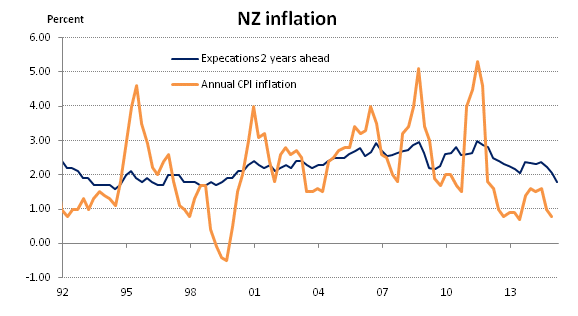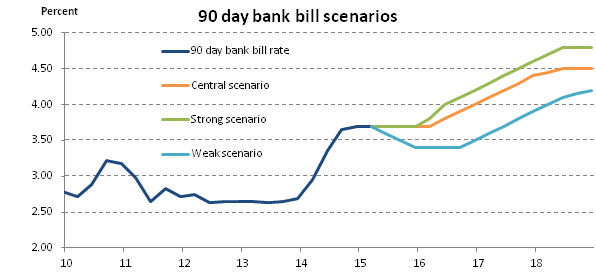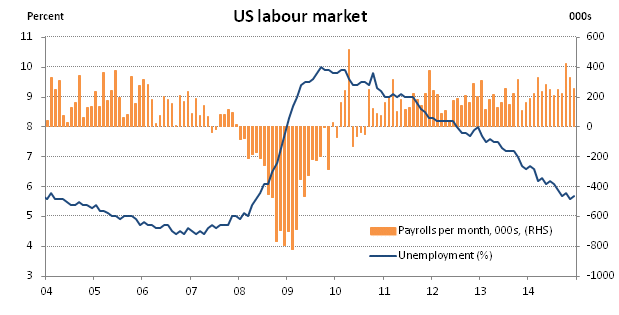A change in the fixed interest soundtrack
Wednesday, March 11th 2015, 9:49AM
by Harbour Asset Management
What’s the theme?
For those TV channel surfing late at night, there is a programme called ‘What’s the theme?’, which shows endless music videos from the same genre – depending what night you switch it on, you will get hours of punk, grunge, heavy metal or cheesy 80s pop.
During the first month of 2015, the unrelenting mood music in financial markets was a medley of falling oil prices, fears of deflation, and expectations of an ECB stimulus package. Over a dozen central banks surprised with dovish policy decisions, and bond yields in many countries hit new lows.
The start of February saw an abrupt change in the soundtrack. With the ECB having delivered its long awaited QE programme, the New Zealand fixed interest markets looked forward and focused on two key issues: the prospects of the US Fed removing stimulus and lifting long term interest rates globally; and in New Zealand whether the RBNZ was really more likely to move the OCR ‘up or down’.
A road map from the RBNZ
In the January OCR Review, the Reserve Bank hinted that the next move in the OCR could either be ‘up or down’, in part as tactical ploy to ensure the New Zealand dollar did not appreciate in an environment where other central banks were loosening monetary policy.
At the start of February, Graeme Wheeler’s speech to the Canterbury Employer’s Chamber of Commerce set out a clear road map of the main issue that will ultimately determine that judgement. The speech spelt out that the key swing factors for the RBNZ are: dairy prices, oil prices, house prices, and the exchange rate. Over the course of February, on balance, many of these factors stabilised, or at least did not add pressure to deliver an imminent rate cut.
- Dairy prices: After falling around 50% over the course of 2014, dairy prices recovered nearly half of that move in February, admittedly on low auction volumes. While the risk of a drought remains, fears of a severe drought have abated with rain arriving in some regions.
- Oil prices: After the price of oil fell from $110 in mid 2014 to $45 in January, it stabilised in a $55-60 range for much of February, reducing near term deflation fears.
- House prices: After moderating to 5% p.a. following LVR restrictions in 2013, annual house price inflation has picked up again, particularly in Auckland. Net migration remains near record highs, suggesting continued pressure on housing resources.
- NZ dollar: Of the four key main issues in the Graeme Wheeler’s speech, the strength of the NZ dollar was the only factor that would have remained a headache for the RBNZ, with the NZ TWI remaining elevated in February.
Perhaps that most important piece of economic data in February was the RBNZ’s own survey of inflation expectations, which have fallen to the lowest level in fifteen years, illustrating that RBNZ should be in absolutely no hurry to lift the OCR from its current level.

In the upcoming March Monetary Policy Statement, we expect the RBNZ to signal that they intend to keep the OCR on hold well into 2016. The message from Graeme Wheeler’s speech is that there is a high hurdle to move the OCR up or down. However, in our opinion, the balance of risks around this forecast is skewed through time, so that in the near term the more likely risk over the next 12 months is that the OCR is cut. We would put around a 25% chance on the OCR being reduced to 3.0 percent by mid 2016.

US Federal Reserve prepares to remove stimulus
While the RBNZ was providing a reality check for local markets, data on the US labour was a clear reminder to global markets that the evidence is building for the US Federal Reserve to start removing stimulus.
Data released at the beginning of February showed that not only had over 200,000 jobs been created in January, but that upward revisions meant the number of job generated in November and December looked even more impressive. The latest out-turn marked the eleventh consecutive month that over 200,000 jobs had been generated in the US, which is a remarkable feat in any economic environment. Importantly, there were the first signs that US wage growth is starting to pick up, which has until recently been a missing ingredient in the US economic expansion.
As a result, the US 10 year government bond yield rose from 1.65% at the start of February to as high as 2.15% during the month, dragging up NZ long-term yields from their lows in January.

Market outlook
At the short end of the yield curve, we continue to expect a period of near term stability. With New Zealand economic growth moderating from a swift pace in mid 2014, the risks to the outlook are more evenly balanced. This means a cut in the OCR is a more plausible scenario if the New Zealand economy was faced with a significant negative shock – so we continue to watch dairy prices, oil prices, house prices, the NZ dollar and inflation expectations.
At the long end of the yield curve, we believe that bond yields are likely to remain relatively low while policy rates are near zero in Europe and the ECB is embarking on QE. However, we see some scope for long-term bond yields to rise modestly from current levels as the US Federal Reserve steps ever closer to removing the ultra loose monetary policy that it has had in place since 2008.
Christian Hawkesby,
Director, Head of Fixed Income & Economics
Harbour Asset Management
Harbour Asset Management’s research is available on their website, see: www.harbourasset.co.nz
www.harbourasset.co.nz/disclaimer/
Important disclaimer information
| « There is such a thing as a good performance fee | Triffin Revisited: Why the Unwinding of the Dilemma Matters » |
Special Offers
Comments from our readers
No comments yet
Sign In to add your comment
| Printable version | Email to a friend |









